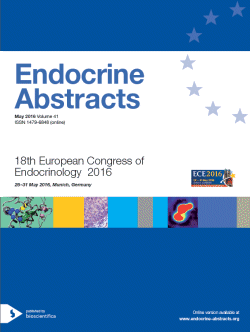Searchable abstracts of presentations at key conferences in endocrinology
Symposia
How to diagnose endocrine disease in obese patients? (<emphasis role="italic">Endorsed by the European Journal of Endocrinology</emphasis>)
ea0041s4.1 | How to diagnose endocrine disease in obese patients? (<emphasis role="italic">Endorsed by the European Journal of Endocrinology</emphasis>) | ECE2016
HPA axis abnormalities and metabolic syndrome
MetS is a cluster of interconnected factors that directly increase the risk of cardiovascular atherosclerotic diseases, and diabetes mellitus type 2. Visceral obesity/insulin resistance have gained increasing attention as the core manifestations of the syndrome. HPA axis is one of the main stress response pathways. Apart from having a circadian activity also mediates the adaptive response to stressors. A growing body of evidence point towards a strong relationship between pert...
ea0041s4.2 | How to diagnose endocrine disease in obese patients? (<emphasis role="italic">Endorsed by the European Journal of Endocrinology</emphasis>) | ECE2016
Male hypogonadism and obesity: how to differentiate cause and consequence
Male hypogonadism is generally associated with overweight or obesity and, in these situations androgen therapy partially, or totally, reverses the excess adiposity. However, the opposing situation, i.e., the role of overweight on a reduction of gonadal function has been scarcely studied. In fact, changes in body morphology are complex because several factors such as age, social and lifestyle influences, and the physiological response to stress can affect both problems, adiposi...
ea0041s4.3 | How to diagnose endocrine disease in obese patients? (<emphasis role="italic">Endorsed by the European Journal of Endocrinology</emphasis>) | ECE2016
Subclinical hypothyroidism and obesity: cause or consequence?
Levels of TSH respond to fluctuations in serum free T(4) (fT(4)) and remain in a very narrow individual range. There exists current controversy regarding the upper limit of normal serum TSH values above which treatment should be indicated. In a cohort of healthy men from the general population, both serum TSH and fT(4).TSH product were positively associated with fasting and postload insulin concentration and negatively with insulin sensitivity.It was concluded that thyroid fun...




